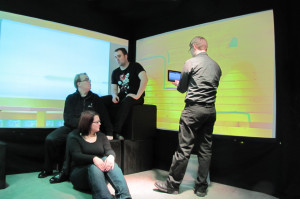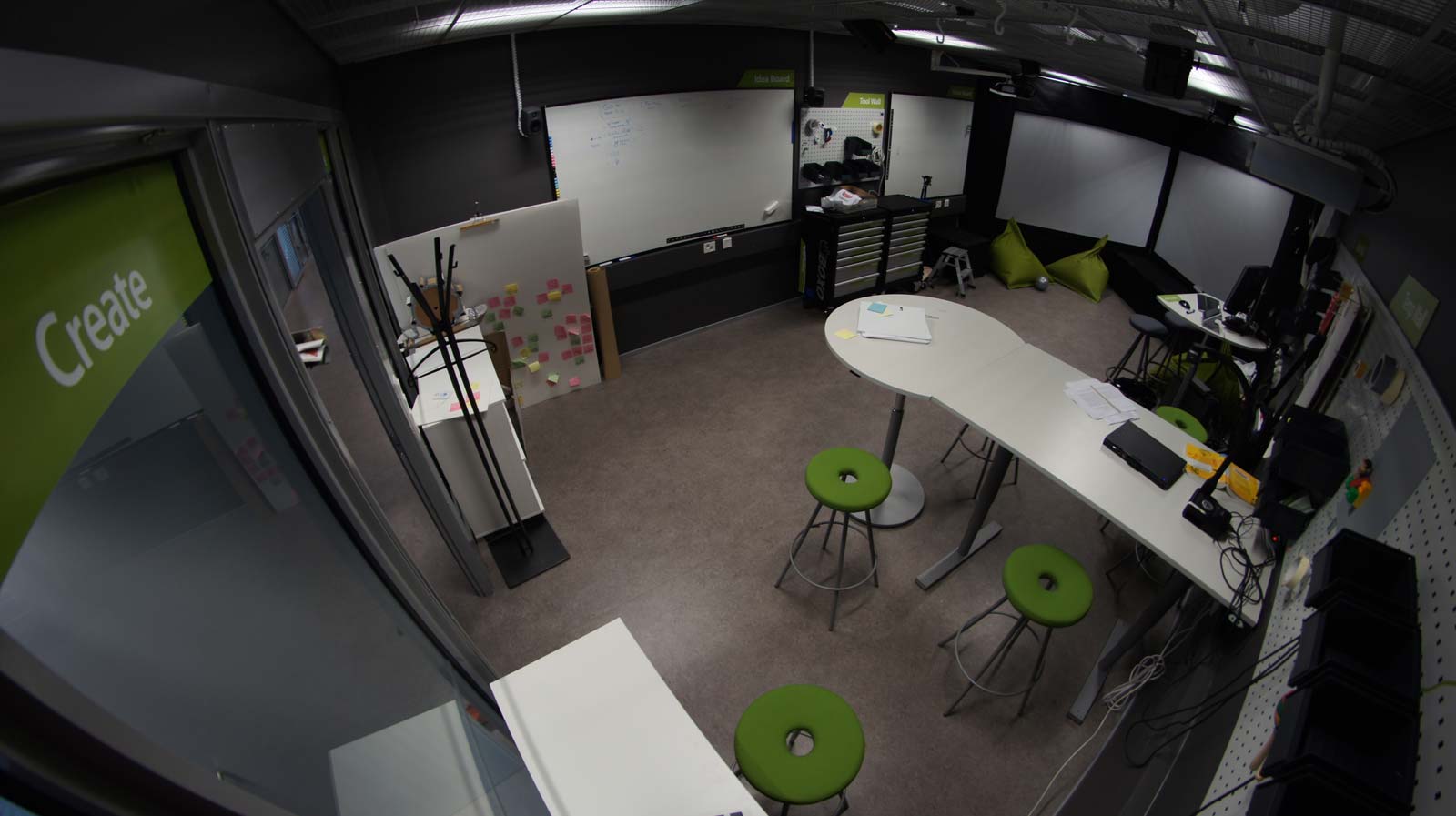01.03
SINCO is a prototyping environment, which makes use of technology and digital materials in order to make it quicker and easier to create an experience prototype – for example of a service.
SINCO’s service stage is like a stage of a hobbyist theatre – with one exception: there is most of the time no audience – everyone gets to participate in the play. The stage is where service prototypes are built, and then by going through – again and again – iteratively developed. While there are similarities between service prototyping and traditional theatre plays, there are also some differences between these two.
In SINCO during several cases we’ve learned few things that are good to keep in mind, when you want to build technology assisted experience prototypes – or are still planning to build an prototyping environment.
1. Keep the interaction physical & on the stage

While the digital material and projectors offer a very efficient way to create visual depth into the existing prototype, it’s not meant to be the only medium used to create the prototype. In fact, most of the stuff the interaction happens with, should exist on the service stage in a physical form (as it does in the real situation) so that there can be some real, physical interaction during the prototyping.
For example, when there’s some computer related task, a search or homepage visit, very often the new-to-tech-assisted-prototyping -people like to put the interface device – computer, that is – on the servicescape simulation screen of the service stage. As a result in the prototype, the computer screen on the is several times bigger, than it is in the real live, inaccessible by the prototypers, and also located at a place (in the background scenery) where it wouldn’t be in the real life. So, instead of putting _everything_ in the background, you should consider every service moment, and split the elements of the moment in two groups: active, and passive elements.
Active elements are the ones, that the person experiencing the service – usually the user – interact with. As technological solutions for this in SINCO, the Digital UI toolkit often offers a solution to concretize aspects, such as a mobile device screen UI. However, don’t try to force in technology when it’s not needed (see tip 4.)
Passive elements are the ones, that bring in the context; the atmosphere, surroundings of the location where service takes place. These may be very essential for the service experience itself, but there’s no twofold interaction between these two elements. For example, on a tourist trip, the Northern Lights would be a very good example of this kind of an element in a service prototype.
2. Keep it quick and dirty
The idea of a rapid prototype is to keep the doing on low fidelity –level, and actions quick. There’s no wrong way to concretize an idea into a prototype: some concretizations just represent the idea better than the others. But ANY concretization is better, than no concretization. So when you concretize something into a prototype, it helps you to evaluate that entity in it. It helps you to get a grasp of what it might look/feel/sound like. After you’ve tested it out, you’ll most likely end with one (or two) of these three results:
A. This doesn’t work here (and you’ll probably come out with a different solution to concretize & try out)
B. This is great, we need this! (And you include that into your concept)
C. This might work, but we need to examine it more closely (And you’ll add fidelity into it, or find an another way to concretize the same idea into the prototype)
Notice, that only in one of the three outcomes, the concretization needs more efforts, time and increased fidelity. Usually, the simplest solution for concretization is enough, so if you come up with a way to concretize an idea, that’s probably an adequate one.
3. Scenery is there for actors, not just a pretty background
The purpose of a stage set-up at the traditional theatre is to inform the audience about the context of the play. However, in prototyping, the aim of servicescape simulation’s scenery is to help the prototypers; the people on the stage to get their mindset into a different place. Thus, the action on the stage is situated so, that the people on stage are facing the background scenery. This way, their view is filled with the imagery of the surroundings of where the service takes place, so it helps them to see the whole service better from the end-user point-of-view.
The scenery can be turned on to the background in the rare situations, when the developed service journey is being re-played to an audience, if such exists in the prototyping space. However, even in this kind of case it is more recommended to take the audience on stage and pull through the prototype with them in an active part, as if they were experiencing the service, instead of letting them take a passive role when introducing the service ideas.
4. Technology is a good servant, but a lousy master
The idea of using technology to build service and experience prototypes is to help and speed up the creation and altering of the prototype. While things like video projectors, speakers, computers and presentation software spiced up with an internet connection help you to access, edit and mix huge amount of digital material to enliven your prototypes.
However, the gizmos and gadgets don’t play the main role in prototyping: The participating people do. They create the ideas, evaluate those, iterate and develop it further, and use all their experience to form the concept, that best fits to the given constrains. Technology’s task – if you can give one for inanimate objects – is to ease and quicken the process of making changes during the iteration: Instead of having to imagine – or repaint – the environment where the service takes place we can just quickly look from an image library, or internet a panorama picture of a similar place (or perhaps prepare ourselves, document the needed material (photos, sounds etc.) in advance so that the action happens as easily and painlessly as it’s possible.
5. Participate as many stakeholders as possible to the process to avoid negativity
Critique is easy to throw in. And it’s double as easy, when the presentation is not polished: some imperfections in concretizing elements in a prototype may cause distraction, and the people evaluating what they’re seeing get caught missing the point and criticizing something completely irrelevant to the idea.
The best way to avoid threats of these is to participate the stakeholders to the project as early, and as often and much as it only realistically is possible. When they are together in it, generating, comparing, iterating the ideas, forming the very first raw concretizations of the ideas, they grow with the project to see the phases from the very concrete level, and get to experience the ideas from several different perspectives, instead of just seeing it once, imperfectly presented using drama methods with amateuristic skills by people who had participated in creating the concept instead of fine-tuning their acting performance to deliver as polished and perfect picture of the service as it’s humanly possible.
How did these tips look for you? Did we miss something important? Tell us about your experiences on technology assisted experience prototyping.

No Comment.
Add Your Comment